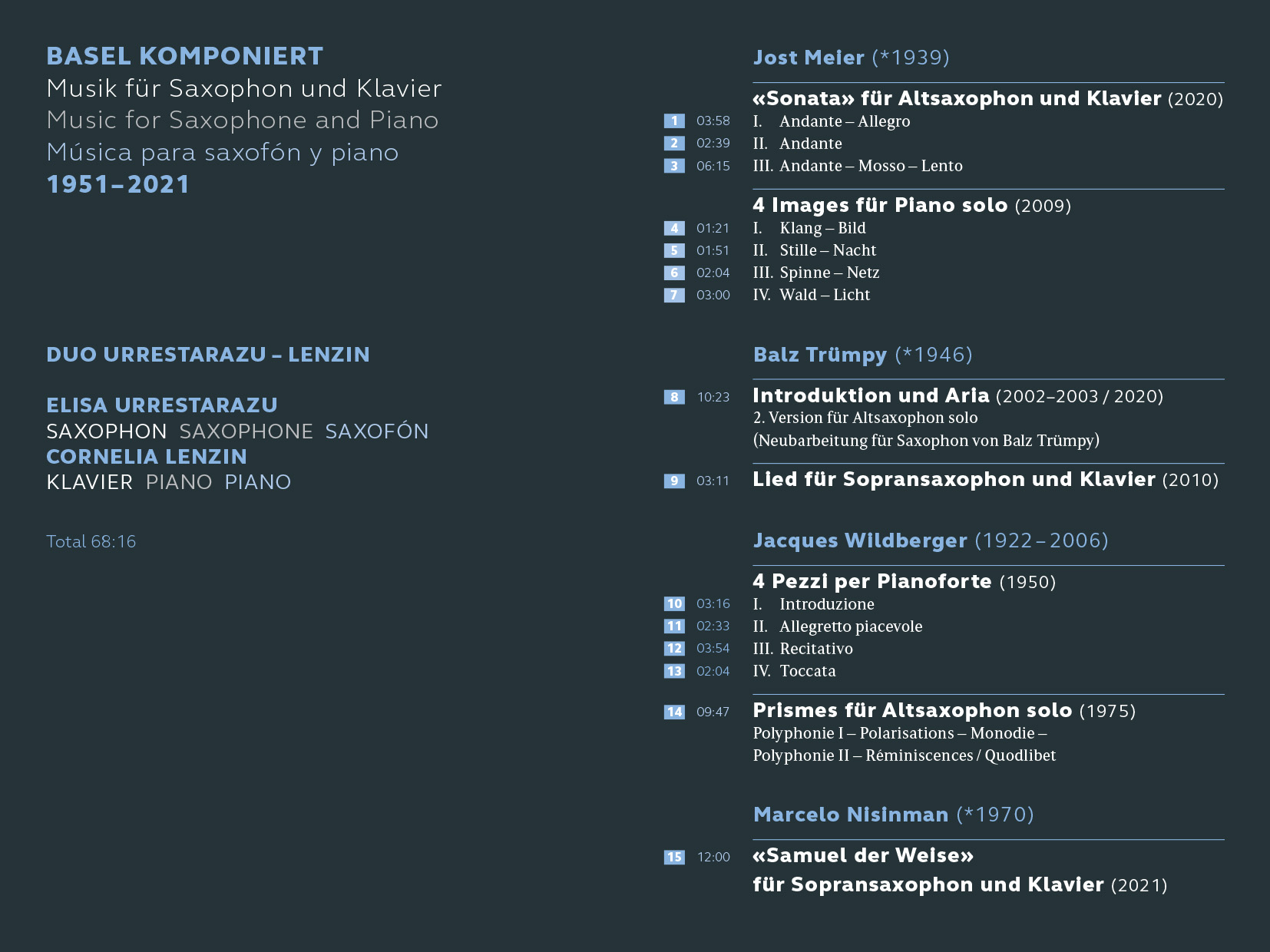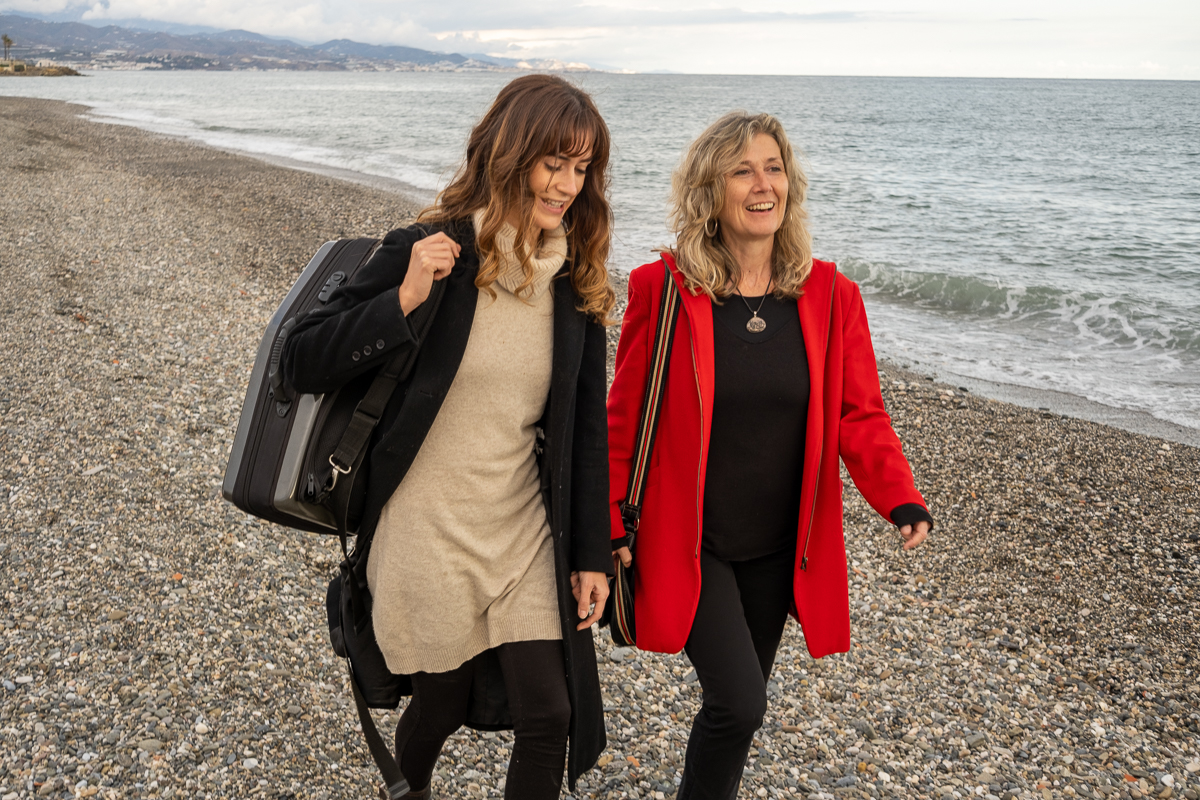Music by Jost Meier, Balz Trümpy, Jacuqes Wildberger und Marcelo Nisinman
Elisa Urrestarazu - Saxophone
Cornelia Lenzin - Piano
Download the E-Booklet for free: ![]() Digitales Booklet Basel komponiert PV115
Digitales Booklet Basel komponiert PV115
Buy the digital album in the PIANOVERSAL SHOP: PIANOVERSAL-SHOP
© PIANOVERSAL

© PIANOVERSAL
BASEL KOMPONIERT:
The Duo Urrestarazu – Lenzin presents in „Basel komponiert“ a multifaceted album with new music from Basel. Both the "Sonata" for saxophone and piano by Jost Meier and the composition "Samuel der Weise" by Marcelo Nisinman were written for the Duo Urrestarazu-Lenzin and premiered on September 1st 2021 in Basel.
«Introduction and Aria» for saxophone solo - originally written for clarinet - has been newly arranged for Elisa Urrestarazu by Balz Trümpy. It is recorded here for the first time.
“4 Images” for piano by Jost Meier is also a first recording. The program is completetd by "4 Pezzi" for piano and "Prismes" for saxophone by Jacques Wildberger, who would have celebrated his 100th birthday in 2022.
Jost Meier «Sonata» for saxophone and piano (2020)
The "Sonata" for saxophone and piano consists of three Phantasies, with different emphasis on expressive melody, tense harmony, instrumental virtuosity, chamber music supplements and rhythmic variety. Abrupt changes in expressiveness and concise rhythms characterize all 3 movements of the Sonata. Actually, I could give each movement the title «Fictional Scenes». Every listener can experience their own scene to the music. My music should be liberating and not explanatory. (Jost Meier)
Jost Meier: «4 Images» for Piano solo (2009)
Four pairs of words separated by a hyphen suggest a relation between each pair (contrast, refinement, conclusion etc.)
I. Klang – Bild (Sound – Image): linear and selective moments are contrasted with a opening- out sound.
II. Stille – Nacht (Silent – Night): Reverberating soft overtones are perceived as silence. The title of this section is a literary reference to the famous Christmas Carol „Silent Night“.
III. Spinne – Netz (Spider – Net): Through the spiders activity (part one), the net is constructed (part two). The existing differences in the net's fine threads are infinitesimal.
IV. Wald – Licht (Forest – Light): Light penetrates sporadically through the branches. When entering the meadow, only the light remains (note: «a»). (Jost Meier)
Balz Trümpy: «Introduktion und Aria» (2002/2003 - 2020)
2nd Version for alto saxophone solo (2020)
“Introduction and Aria” consists of two parts, connected through attacca, and also related to each other thematically. The melody played fortissimo in an extreme register, which appears in the middle of the introduction, forms the pianissimo beginning of the aria, the development of which in turn leads back to the beginning of the introduction. The piece explores the spectrum of technical possibilities of the alto saxophone without using any special playing techniques. The 2nd version of the introduction and aria is dedicated to the saxophonist Elisa Urrestarazu. (Balz Trümpy)
Balz Trümpy: «Lied» for soprano saxophone and piano (2010 /2011)
“Lied” is the fifth piece from my cycle To Florestan and Eusebius (2010/2011). This work for saxophone, trombone and piano was written as a tribute to Schumann, whose intricate counterpoint greatly influenced my composing. „Song“ rises up to a climax in the dialogue between soprano saxophone and piano, subsequently calming down. (Balz Trümpy)
Jacques Wildberger: «4 Pezzi per Pianoforte» (1950) und «Prismes» (1975)
Engagement und Pfauenrad (Engagement and peacock feather-wheel)
"I have to have a purpose!" Jacques Wildberger is known as a composer of music which meddles, takes a political stance. What is often overlooked is that he also wrote a long series of extremely precious instrumental solo pieces that are not politically motivated.
These mostly virtuoso works should give performers the opportunity to "show their peacock feather-wheel".
Wildberger, who had completed his studies as a pianist in Basel in 1944, wrote "Quattro Pezzi" (1950) for his own instrument. This is his Opus 1, so to speak, the first presentable result of his compositional training with the exiled Russian composer Vladimir Vogel, who instructed him in twelve-tone technique. In the conservative Swiss musical life of the time, this was definitely a political issue insofar as Wildberger entered the aesthetic opposition to the prevailing conservative neoclassicism. It is astonishing how confidently he already unfolds the twelve-tone technique in the early pieces, as if he wanted to prove how versatile and eloquent it is: Scriabin-like sound fields, refined counterpoint, eloquent recitative, highly virtuoso motor skills - almost anything seems possible. The mission of the young Wildberger is urgent, but the resulting music is not obtrusive, but transparent, sensitive to sound, predominantly graceful in character, which is particularly evident in the present interpretation.
The "Pezzi" are a testament to the successful acquisition of a new idiom. Since the experience of the 1968 movement, finding language has played a different role in Wildberger's music: In view of the historical and prevailing crises, he sees the conventional possibilities of musical expression strongly called into question. Thus he could only compose with reservations. In many works, musical language literally has to be reassembled from splinters and shards. This is also clearly noticeable at the beginning of «Prismes», which he composed in 1975 for a colleague at the Basel Conservatory, the professor for saxophone, Iwan Roth. However, this approach to music is extremely playful, leading to many stages where soloists are able to demonstrate their skills in great versatility. "Contemporary playing techniques" that were new at the time are also used, sometimes perhaps not without a twinkle, for example when spectacular multiphonic sounds are unfolded in a "monody" of all things. At the end, well-known foreign voices finally have their say, perhaps not entirely unironic: in addition to Coleman Hawkins, there are also the old masters of the classical saxophone (Mussorgsky, Ravel, Bizet, Berg, Ibert).
These two solo pieces indicate that "Engagement" and "Pfauenrad" are perhaps not established in completely disconnected spheres, and how virtuoso solo repertoire can also be critically informed. (Michael Kunkel)
Marcelo Nisinman «Samuel der Weise» for soprano saxophone and piano (2021)
The piece "Samuel der Weise" (Samuel the wise) is inspired by the life and work of Samuel Nisinman, son of Russian immigrants who came to Buenos Aires at the beginning of the 20th century. One could say that the form of the piece is classical, but its language is in many moments atonal, dissonant and breaks with the "typical" harmonic consequences of traditional tango music. A music that deeply connects the old roots of a traditional Europe with the new world of the Río de la Plata and merges with a current musical language and special sounds for saxophone to create truly unique music. (Marcelo Nisinman)
Kostenloses E-Bookle als pdf: ![]() Digitales Booklet Basel komponiert PV115
Digitales Booklet Basel komponiert PV115
Kaufen Sie das digitale Album im PIANOVERSAL SHOP: PIANOVERSAL-SHOP

ELISA URRESTARAZU & CORNELIA LENZIN
© PIANOVERSAL
